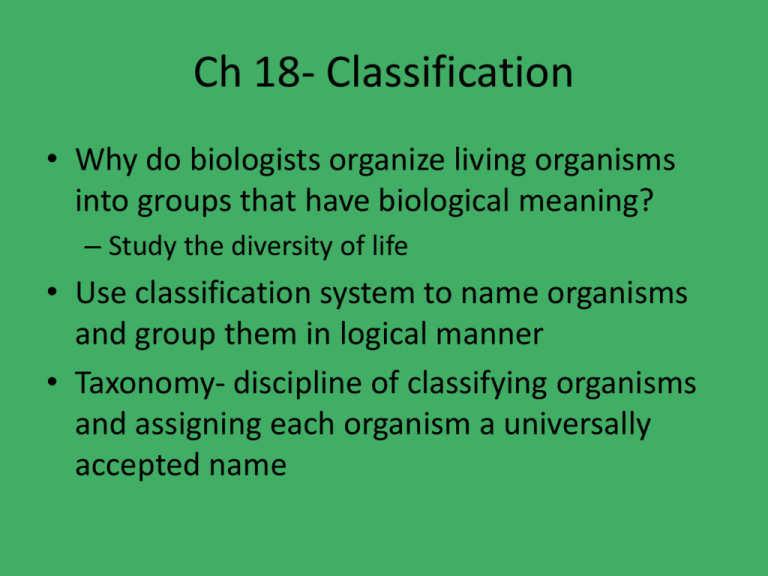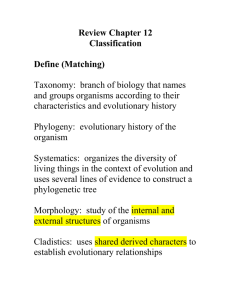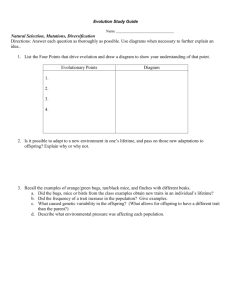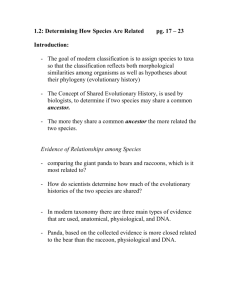Ch 18- Classification
advertisement

Ch 18- Classification • Why do biologists organize living organisms into groups that have biological meaning? – Study the diversity of life • Use classification system to name organisms and group them in logical manner • Taxonomy- discipline of classifying organisms and assigning each organism a universally accepted name Scientific Names • Why don’t scientists use common names? • Use Latin and Greek • Bionomial nomenclature- two word naming system – Each species given two-part scientific name – Carolus Linnaeus – First word is capitalized, second word is lowercased, written in italics – Ursus arctos- grizzly bear • Ursus- genus to which organism belongs – Genus- group of closely related species • artos- unique to each species within the genus Linnaeus’s System of Classification • Linnaeus’s hierarchical system of classification uses seven taxonomic categories – – – – – – – • • Species Genus Family Order Class Phylum Kingdom Taxon- taxonomic category Family- genera that share many characteristics – Ursidae • Order- broad taxonomic category composed of similar families – Carnivora • Class- composed of similar orders – Mammalia • Phylum- several classes that share important characteristics – Chordata • Kingdom- largest and most inclusive categories – Animalia Sec 2- Modern Evolutionary Classification • Phylogeny- evolutionary relationships among organisms • How are evolutionary relationships important in classification? – Organisms are grouped into categories that represent lines of evolutionary descent, or phylogeny- not just physical similarities • Evolutionary classification- grouping organisms together based on their evolutionary history Classification Using Cladograms • Cladistic analysis identifies new characteristics that arise as lineages evolve over time • Derived characters- characteristics that appear in recent parts of a lineage but not in its older members – Evolutionary innovation, or new characteristics • Cladogram- diagram that shows evolutionary relationships among group of organisms – Help understand how one lineage branched from another – Use derived characters Similarities in DNA and RNA • All organisms use DNA and RNA to pass on information • How can DNA and RNA help scientists determine evolutionary relationships? – Genes of many organisms show important similarities at molecular level – Can be used to determine classification and evolutionary relationships • Similar genes – Human muscles and yeast • DNA evidence – More similar DNA sequence of two species, the more recently they shared a common ancestor – American vulture, African vulture, stork Molecular Clocks • Uses DNA comparisons to estimate the length of time that two species have been evolving independently • Relies on mutations • Comparison between DNA sequences can reveal how dissimilar the genes are- indicates how long ago two species shared a common ancestor Sec 3- Kingdoms and Domains • How many kingdoms of life are there? • What are the 6 kingdoms? – – – – – – Eubacteria Archaebacteria Protista Fungi Plantae Animalia • Domain- taxonomic category larger than kingdom – Eukarya- composed of protists, fungi, plants, animals – Bacteria- Eubacteria – Archaea- Archaebacteria Domain Bacteria and Archaea • Bacteria- unicellular and prokaryotic – – – – Thick, rigid cell walls Ecologically diverse- free living to deadly parasites Some photosynthetic, some not Some depend on oxygen, some not • Archaea- unicellular and prokaryotic – – – – Most extreme environments Many survive only in absence of oxygen Cell walls lack peptidoglycan Unusual lipids in cell membranes, not found in any other organism Domain Eukarya • All have nucleus • Protista, Fungi, Plantae, Animalia • Protista- display greatest variety – Unicellular and multicellular – Photosynthetic and heterotrophic • Fungi- heterotrophs – Feed on dead or decaying organic matter – Unicellular or multicellular • Plantae- multicellular organisms that are photosynthetic autotrophs • Animalia- multicellular and heterotrophic – Incredible diversity







